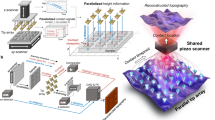Abstract
Non-destructive, nanoscale characterization techniques are needed to understand both synthetic and biological materials. The atomic force microscope uses a force-sensing cantilever with a sharp tip to measure the topography and other properties of surfaces1,2. As the tip is scanned over the surface it experiences attractive and repulsive forces that depend on the chemical and mechanical properties of the sample. Here we show that an atomic force microscope can obtain a range of surface and subsurface information by making use of the nonlinear nanomechanical coupling between the probe and the sample. This technique, which is called mode-synthesizing atomic force microscopy, relies on multi-harmonic forcing of the sample and the probe. A rich spectrum of first- and higher-order couplings is discovered, providing a multitude of new operational modes for force microscopy, and the capabilities of the technique are demonstrated by examining nanofabricated samples and plant cells3,4.
This is a preview of subscription content, access via your institution
Access options
Subscribe to this journal
Receive 12 print issues and online access
$259.00 per year
only $21.58 per issue
Buy this article
- Purchase on Springer Link
- Instant access to full article PDF
Prices may be subject to local taxes which are calculated during checkout


 -modes.
-modes.

Similar content being viewed by others
References
Sahin, O. et al. An atomic force microscope tip designed to measure time-varying nanomechanical forces. Nature Nanotech. 2, 507–514 (2007).
Garcia, R., Margerle, R. & Perez, R. Nanoscale compositional mapping with gentle forces. Nature Mater. 6, 405–411 (2007).
Lynd, L. R. et al. How biotech can transform biofuels. Nature Biotechnol. 26, 169–172 (2008).
Donohoe, B. S. et al. Visualizing lignin coalescence and migration through maize cell walls following thermochemical pretreatment. Biotech. Bioeng. 101, 913–925 (2008).
Lemons, R. A. & Quate, C. F. Acoustic microscope—scanning version. Appl. Phys. Lett. 24, 163–165 (1974).
Ilett, C., Somekh, M. G. & Briggs, G. A. D. Acoustic microscopy of elastic discontinuities. Proc. R. Soc. Lond. A 393, 171–183 (1984).
Akamine, S., Hadimioglu, B., Khuri-Yakub, B. T., Yamada, H. & Quate, C. F. Acoustic microscopy beyond the diffraction limit: an application of microfabrication. 1991 Int. Conf. on Solid-State Sensors and Actuators, Digest of Technical Papers, Transducers '91, 857–859 (1991).
Kolosov, O. et al. Nonlinear detection of ultrasonic vibrations in an atomic force microscope. Jpn J. Appl. Phys. 32, L095–L098 (1993).
Cuberes, M. T., Assender, H. E., Briggs, G. A. D. & Kolosov, O. V. Heterodyne force microscopy of PMMA/rubber nanocomposites: nanomapping of viscoelastic response at ultrasonic frequencies. J. Phys. D 33, 2347–2355 (2000).
Shekhawat, G. S. & Dravid, V. P. Nanoscale imaging of buried structures via scanning near-field ultrasound holography. Science 310, 89–92 (2005).
Tetard, L. et al. Imaging nanoparticles in cells by nanomechanical holography. Nature Nanotech. 3, 501–505 (2008).
Tetard, L. et al. Elastic phase response of silica nanoparticles buried in soft matter. Appl. Phys. Lett. 93, 133113 (2008).
Lozano, J. R. & Garcia, R. Theory of phase spectroscopy in bimodal atomic force microscopy. Phys. Rev. B 79, 014110 (2009).
Lozano, J. R. & Garcia, R. Theory of multifrequency atomic force microscopy. Phys. Rev. Lett. 100, 076102 (2008).
Platz, D., Tholen, E. A., Pesen, D. & Haviland, D. B. Intermodulation atomic force microscopy. Appl. Phys. Lett. 92, 153106 (2008).
Cosgrove, D. J. Growth of the plant cell wall. Nature Rev. Mol. Cell Biol. 6, 850–861 (2005).
Boyd, R. W. Nonlinear Optics 2nd edn (Academic Press, 2002).
Rabe, U., Janser, K. & Arnold, W. Vibrations of free and surface-coupled atomic force microscope cantilevers: theory and experiment. Rev. Sci. Instrum. 67, 3281–3293 (1996).
Acknowledgements
This research was sponsored by the Oak Ridge National Laboratory (ORNL) BioEnergy Science Center (BESC). The BioEnergy Science Center is a US Department of Energy (DOE) Bioenergy Research Center supported by the Office of Biological and Environmental Research in the DOE Office of Science. We are indebted to J. Seokwon and A. Ragauskas at the Georgia Institute of Technology for providing the poplar wood samples. We also thank B. Davison and M. Keller at ORNL for their support and useful discussions. ORNL is managed by UT-Battelle, LLC, for the US DOE under contract DE-AC05-00OR22725.
Author information
Authors and Affiliations
Contributions
L.T., A.P. and T.T. designed and carried out the experiments, and wrote the manuscript.
Corresponding author
Ethics declarations
Competing interests
The authors declare no competing financial interests.
Supplementary information
Supplementary information
Supplementary information (PDF 1115 kb)
Rights and permissions
About this article
Cite this article
Tetard, L., Passian, A. & Thundat, T. New modes for subsurface atomic force microscopy through nanomechanical coupling. Nature Nanotech 5, 105–109 (2010). https://doi.org/10.1038/nnano.2009.454
Received:
Accepted:
Published:
Issue Date:
DOI: https://doi.org/10.1038/nnano.2009.454
This article is cited by
-
Force spectroscopy of single cells using atomic force microscopy
Nature Reviews Methods Primers (2021)
-
Real-space visualization of intercalated water phases at the hydrophobic graphene interface with atomic force microscopy
Frontiers of Physics (2020)
-
Local electrical characterization of two-dimensional materials with functional atomic force microscopy
Frontiers of Physics (2019)
-
Fast and high-resolution mapping of elastic properties of biomolecules and polymers with bimodal AFM
Nature Protocols (2018)
-
Interaction between a punch and an arbitrary crack or inclusion in a transversely isotropic half-space
Zeitschrift für angewandte Mathematik und Physik (2018)



